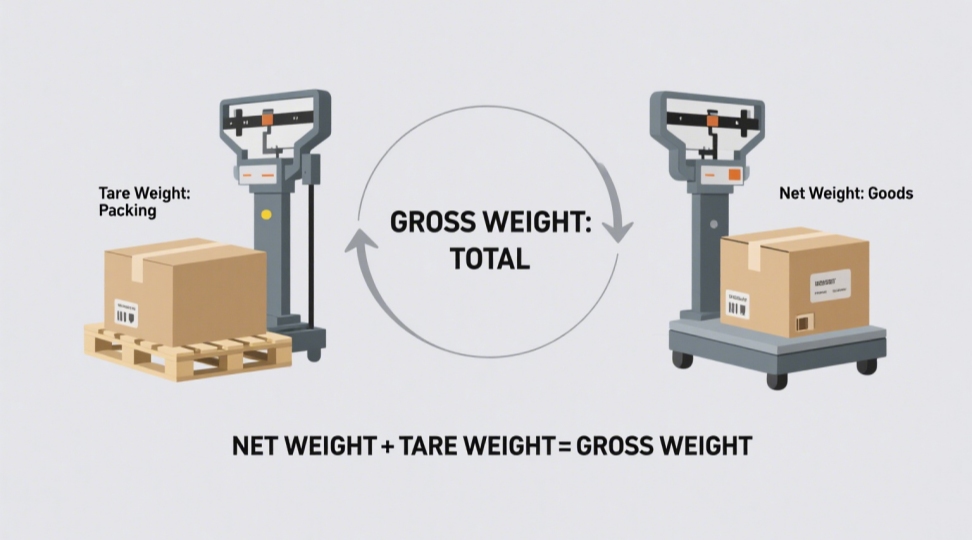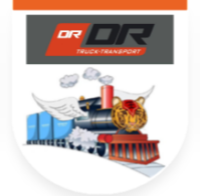Signification du poids à vide, du poids net et du poids brut
Lors de vos échanges internationaux, avez-vous déjà été déconcerté par l'apparition répétée de la tare, du poids net et du poids brut sur les documents logistiques ? Avez-vous déjà craint qu'une déclaration de poids inexacte n'entraîne une retenue douanière, des frais supplémentaires, voire une altération de l'ensemble du plan de transport ?
Il ne s'agit en aucun cas d'une exagération. Dans la chaîne logistique internationale complexe, comprendre et distinguer précisément la tare, le poids net et le poids brut est une compétence fondamentale que toute personne impliquée dans le transport de marchandises doit maîtriser. La confusion entre ces concepts n'est pas une simple erreur de compréhension des termes de transport. Elle est directement liée à l'exactitude de votre comptabilité analytique, à la fluidité du dédouanement, au respect des normes de sécurité des transports, et même à la réussite ou à l'échec de votre entreprise !
En tant que partenaire logistique international professionnel, profondément ancré sur des marchés clés tels que la Chine, l'Europe, l'Asie centrale, la Russie et la Biélorussie, DR Trans connaît parfaitement la signification du terme « poids » dans le transport international. Cet article vous expliquera en détail la définition, les méthodes de calcul et les différences fondamentales entre « tare, poids net et poids brut », vous aidant ainsi à naviguer sereinement dans le commerce international et à éviter les embûches liées à un poids imprécis.
1. Poids à vide : le poids du vide
Qu'est-ce que le poids à vide ?
En termes simples, la tare désigne le poids du conteneur ou de l'emballage vide contenant vos marchandises. le poids de tout sauf le produit réel que vous expédiez. Cela comprend :
Conteneurs d'expédition (20 pieds, 40 pieds, high-cube)
Palettes (en bois, en plastique, en métal)
Caisses, fûts, barils, conteneurs IBC
Cerclage, emballage et calage (matériel utilisé pour sécuriser la cargaison)
Châssis de remorque (pour le transport de conteneurs)
Comment déterminer le poids à vide ?
Trouver la valeur de la tare est généralement simple :
Marquages du fabricant : La plupart des conteneurs normalisés et des grands emballages ont leur poids à vide estampillé ou peint de façon permanente (par exemple, sur les portes des conteneurs).
Pesée: Pour les emballages non standard (comme les caisses ou les palettes personnalisées), le pesage physique de l'emballage vide sur une balance calibrée permet de calculer le poids à vide.
Documentation: Les documents des compagnies maritimes ou des dépôts de conteneurs indiquent toujours la tare des conteneurs loués. Les fournisseurs fiables fournissent les spécifications de poids des palettes.
Pourquoi le poids à vide est-il important ?
Comprendre la tare est essentiel pour calculer avec précision le poids réel de votre cargaison (poids net) et éviter des frais d'expédition inutiles liés à un surpoids d'emballage. C'est l'élément fondamental pour comprendre la différence entre poids net et poids brut.
2. Poids net : le poids réel de la cargaison
Qu'est-ce que le poids net ?
La définition du poids net est le poids des marchandises réellement expédiées, sauf Tous les emballages, conteneurs et calages. Ils représentent le poids net de votre produit, la précieuse marchandise que vous envoyez à votre client.
Comment déterminer le poids net ?
Le calcul précis du poids net implique généralement :
Peser la marchandise : Avant tout emballage, pesez les articles individuellement ou l'ensemble du lot à l'aide d'une balance étalonnée. C'est la méthode la plus directe pour calculer le poids net.
Soustraction du poids à vide : Si vos marchandises sont déjà emballées, pesez l'ensemble du colis (ce qui vous donne le poids brut) puis soustrayez le poids à vide connu de l'emballage : Poids net = Poids brut - Poids à videCette méthode met en évidence la relation entre le poids net et le poids à vide.

Pourquoi le poids net est crucial ?
Valeur commerciale : Souvent utilisé pour la facturation et la détermination de la valeur du produit.
Déclarations en douane : Les autorités douanières se soucient principalement du poids net (et de la valeur) des marchandises pour le calcul des droits et taxes. Incorrect déclaration du poids net peut entraîner des retards importants.
Conformité réglementaire : De nombreuses réglementations en matière d’étiquetage des produits (comme les biens de consommation) exigent un affichage clair du poids net.
3. Poids brut : la charge totale de l'expédition
Qu'est-ce que le poids brut ?
La définition du poids brut englobe le poids total combiné de tout ce qui est expédié. Cela comprend :
Le poids net (les marchandises réelles)
Le poids à vide (tous les emballages, conteneurs, palettes)
Tout matériel de fixation (calage, sangles)
Tout autre article inclus dans l’unité d’expédition (par exemple, des palettes sous un conteneur).
Comment déterminer le poids brut ?
Le calcul du poids brut est généralement la mesure la plus directe :
Pesée de l'unité entière : La méthode la plus courante et la plus précise consiste à placer l'unité d'expédition entièrement chargée et sécurisée (conteneur sur châssis, marchandises palettisées, caisse) sur un pont-bascule ou un pont-bascule certifié. Cela permet d'obtenir la valeur définitive. poids brut réelC'est le poids qui compte le plus pour le transport.
Pourquoi le poids brut est-il essentiel ?
Frais de transport : Les frais de transport (maritime, aérien, ferroviaire, routier) sont principalement basés sur le poids brut ou le poids volumétrique (le plus élevé des deux). Un calcul précis du poids brut est essentiel pour établir une tarification correcte et éviter les frais de pesée.
Sécurité: Dépasser les limites de poids brut maximal pour les conteneurs, les remorques, les unités de chargement (ULD) d'aéronefs ou les wagons est illégal et extrêmement dangereux. Cela risque de provoquer des accidents et d'endommager les infrastructures.
Conformité réglementaire : Le respect des limites de poids brut est strictement appliqué par les autorités de transport du monde entier. Comprendre la réglementation relative au poids brut permet d'éviter les amendes et les refus d'expédition.
Tare, Net, Brut : la relation visualisée
Ce tableau résume les principales différences et calculs :
| Concept | Ce que cela comprend | Comment le déterminer | Importance primordiale |
|---|
| Poids à vide | Conteneur vide, palette, emballage, calage, sangles. | Marquages du fabricant (conteneurs), pesée des emballages vides et documentation. | Fondamental pour le calcul du poids net. Évite de payer pour l'emballage d'expédition. |
| Poids net | UNIQUEMENT les marchandises/produits réellement expédiés. | Pesée des marchandises avant emballage ; OU Poids brut - Poids à vide. | Valeur commerciale, droits de douane et taxes, conformité de l'étiquetage des produits. |
| Poids brut | TOUT : Poids net + Poids à vide + calage/sangles + palette sous conteneur. | Pesage direct de l'unité entièrement chargée et prête à être expédiée (conteneur, palette, caisse) sur une balance. | Coûts et frais de transport, conformité en matière de sécurité et limites de poids réglementaires. |

4. Au-delà des bases : réglementations internationales et meilleures pratiques
Comprendre les définitions de la tare, du poids net et du poids brut n'est qu'un début. Naviguer dans le transport maritime international exige de connaître les principales réglementations :
Masse brute vérifiée (VGM - SOLAS) : Une réglementation internationale essentielle concernant le poids des marchandises expédiées. Pour le fret maritime, l'expéditeur (ou une partie désignée par lui) doit fournir la masse brute vérifiée (MBV) d'un conteneur emballé avant son chargement sur un navire. Cette information peut être obtenue soit en pesant le conteneur emballé (méthode 1), soit en pesant tout le contenu et en ajoutant la tare (méthode 2), avec des exigences de certification strictes. En cas de non-conformité, le conteneur ne pourra pas naviguer.
Fret aérien (poids volumétrique) : Les compagnies aériennes facturent en fonction du poids facturé, soit le poids brut réel ou le poids volumétrique (calculé selon la formule (L x l x H en cm)/6 000 ou (L x l x H en pouces)/366). Connaître votre poids brut réel et savoir calculer le poids volumétrique est essentiel pour calculer précisément les coûts du fret aérien.
Limites de poids du fret routier et des essieux : Particulièrement crucial pour Transport TIR En Europe et en Asie, les poids par essieu et les combinaisons de véhicules sont soumis à des limites légales strictes. Toute surcharge entraîne de lourdes amendes et des retards. Le respect du poids total en charge est primordial.
Limites de poids du fret ferroviaire : Les opérateurs ferroviaires appliquent des limites de poids brut maximal par wagon et par configuration de train. Une déclaration précise du poids garantit un transit fluide.
Précision douanière : Comme mentionné précédemment, des déclarations de poids net incorrectes sur les factures commerciales ou les documents douaniers (comme la liste de colisage) constituent un signal d'alarme majeur, pouvant entraîner des inspections, des retards, des pénalités et une saisie potentielle des marchandises. La déclaration précise du poids net est essentielle.
Comment DR Trans simplifie les complexités de poids pour vos expéditions à l'ouest de la Chine
S'y retrouver dans les subtilités des écarts de tare net brut, de la VGM, des réglementations internationales et des exigences spécifiques à chaque mode (notamment dans des régions comme l'Asie centrale, la Russie et l'Europe) exige une expertise. C'est là qu'un partenariat avec un prestataire logistique spécialisé comme DR Trans fait toute la différence.
Conseils d'experts : Nous démystifions la tare, le calcul du poids net et la détermination du poids brut, spécifiques à votre cargaison et au mode choisi (ferroviaire, aérien, maritime). Nous garantissons que vos documents reflètent les poids corrects pour les douanes et le transport.
Conformité VGM : Nous gérons avec expertise l'intégralité du processus de vérification de la masse brute de vos expéditions maritimes, garantissant une conformité parfaite et évitant les retards coûteux au port. Nous maîtrisons les différences entre poids net et poids brut dans le contexte de la convention SOLAS.
Solutions modales optimales : Forts de notre expertise dans le fret ferroviaire entre la Chine et des marchés clés comme l'Allemagne, les Pays-Bas, la Pologne, la Russie, la Biélorussie et l'Asie centrale, nous proposons des solutions terrestres efficaces et économiques. Nous prenons également en charge avec expertise le fret aérien et maritime sur les itinéraires les plus adaptés.
Expertise TIR : Nos carnets TIR garantissent des passages frontaliers plus rapides pour le transport routier dans de nombreux pays, réduisant ainsi les délais de transit et les formalités administratives. Des déclarations de poids précises sont essentielles au bon déroulement des opérations TIR.
Navigation réglementaire : Nous restons au courant des dernières réglementations en matière de poids et des exigences de conformité sur tous nos corridors (Europe, Russie, CEI), garantissant que vos expéditions respectent toutes les règles internationales de poids d'expédition.
Support de bout en bout : De la consultation initiale sur le poids et les conseils d'emballage à la préparation des documents, au dédouanement et au suivi de la livraison finale, DR Trans gère les complexités. Nous résolvons les problèmes de calcul de la tare et tout ce qui va au-delà.
Conclusion : La connaissance du poids est un pouvoir dans la logistique mondiale
Maîtriser la différence entre poids net et poids brut, et bien comprendre la tare, n'est pas seulement un jargon logistique : c'est un élément fondamental de l'intelligence économique. Des calculs de poids précis impactent vos résultats grâce à des frais de transport corrects, garantissent la conformité réglementaire (comme la VGM), préviennent les retards et pénalités coûteux aux frontières et aux ports, et garantissent la sécurité de votre cargaison tout au long de son transport.
Ne laissez pas la confusion sur les poids devenir un obstacle à votre réussite commerciale internationale. Faites appel à DR Trans. Notre expertise approfondie du fret ferroviaire, aérien et maritime, combinée à nos compétences TIR et à notre connaissance pointue des marchés, de l'Asie centrale à l'Europe occidentale, garantit une gestion précise, conforme et efficace du poids de vos marchandises, du point d'origine à la destination.
Prêt à expédier en toute confiance ? Contact DR Trans aujourd'hui pour une solution logistique sur mesure qui gère les poids, afin que vous puissiez vous concentrer sur la croissance de votre activité mondiale.
















 IPv6 RÉSEAU PRIS EN CHARGE
IPv6 RÉSEAU PRIS EN CHARGE
